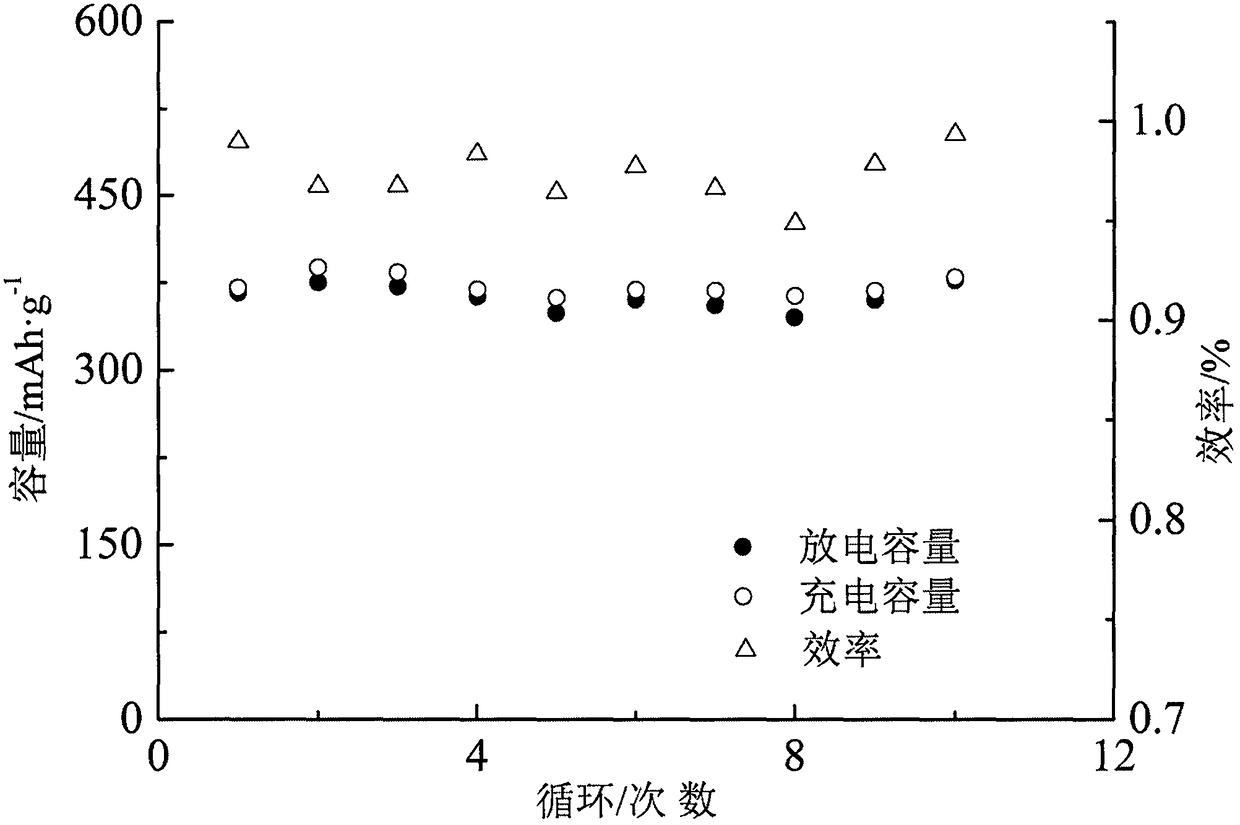A template synthesis double perovskite potassium ion battery negative electrode material and preparation method thereof
A double perovskite and battery negative electrode technology, applied in battery electrodes, secondary batteries, chemical instruments and methods, etc., can solve problems such as weak lithium ion diffusion ability, slow potassium ion migration speed, and large electrochemical polarization. To achieve the effect of accelerating the migration ability of potassium ions and the rate of redox reaction, reducing the resistance of electron migration and improving the conductivity of potassium ions
- Summary
- Abstract
- Description
- Claims
- Application Information
AI Technical Summary
Problems solved by technology
Method used
Image
Examples
Embodiment 1
[0021] Embodiment 1: potassium nitrate, yttrium nitrate hexahydrate, barium nitrate, chromium nitrate nonahydrate, zinc nitrate hexahydrate, ammonium molybdate tetrahydrate, ferric nitrate nonahydrate according to the stoichiometric formula KY 0.8 Ba 0.2 Cr 0.9 Zn 0.1 Mo 0.9 Fe 0.1 o 6 The ratio of mixing, adding the amount of citric acid that is 5.0 times the amount of total metal ion substances and adding water to stir evenly to form a total metal ion concentration of 1.0mol L -1 The initial aqueous solution; mix and dissolve 6g acrylamide / 100mL water volume of acrylamide and 1g N,N'-methylenebisacrylamide / 100mL water volume N,N'-methylenebisacrylamide and water, and the acrylamide in the solution The amount of the substance is 0.5 times the amount of the total metal ion substance in the initial aqueous solution; use a polytetrafluoroethylene stirring paddle to stir at a speed of 1500rpm for 5 minutes, then raise it to 75°C at a speed of 5°C / min and maintain the tempera...
Embodiment 2
[0022] Embodiment 2: potassium nitrate, yttrium nitrate hexahydrate, barium nitrate, chromium nitrate nonahydrate, zinc nitrate hexahydrate, ammonium molybdate tetrahydrate, ferric nitrate nonahydrate according to the stoichiometric formula KY 0.8 Ba 0.2 Cr 0.9 Zn 0.1 Mo 0.9 Fe 0.1 o 6 The proportion of mixing, the amount of substance added is citric acid 10 times the amount of total metal ion substances, and water is added to stir evenly to form a total metal ion concentration of 2.5mol L -1 The initial aqueous solution; mix and dissolve 6g acrylamide / 100mL water volume of acrylamide and 1g N,N'-methylenebisacrylamide / 100mL water volume N,N'-methylenebisacrylamide and water, and the acrylamide in the solution The amount of the substance is 0.8 times the amount of the total metal ion substance in the initial aqueous solution; use a polytetrafluoroethylene stirring paddle to stir at a speed of 1800rpm for 10 minutes, then raise it to 80°C at a speed of 7°C / min and maintain...
Embodiment 3
[0023] Embodiment 3: potassium nitrate, yttrium nitrate hexahydrate, barium nitrate, chromium nitrate nonahydrate, zinc nitrate hexahydrate, ammonium molybdate tetrahydrate, ferric nitrate nonahydrate according to the stoichiometric formula KY 0.8 Ba 0.2 Cr 0.9 Zn 0.1 Mo 0.9 Fe 0.1 o 6 The proportion of mixing, adding the amount of citric acid that is 8 times the amount of the total metal ion substance, adding water and stirring evenly to form a total metal ion concentration of 2.0mol L -1 The initial aqueous solution; mix and dissolve 6g acrylamide / 100mL water volume of acrylamide and 1g N,N'-methylenebisacrylamide / 100mL water volume N,N'-methylenebisacrylamide and water, and the acrylamide in the solution The amount of the substance is 1.2 times the amount of the total metal ion substance in the initial aqueous solution; use a polytetrafluoroethylene stirring paddle to stir at a speed of 2000rpm for 15 minutes, then raise it to 85°C at a speed of 10°C / min and maintain t...
PUM
 Login to View More
Login to View More Abstract
Description
Claims
Application Information
 Login to View More
Login to View More - R&D
- Intellectual Property
- Life Sciences
- Materials
- Tech Scout
- Unparalleled Data Quality
- Higher Quality Content
- 60% Fewer Hallucinations
Browse by: Latest US Patents, China's latest patents, Technical Efficacy Thesaurus, Application Domain, Technology Topic, Popular Technical Reports.
© 2025 PatSnap. All rights reserved.Legal|Privacy policy|Modern Slavery Act Transparency Statement|Sitemap|About US| Contact US: help@patsnap.com

